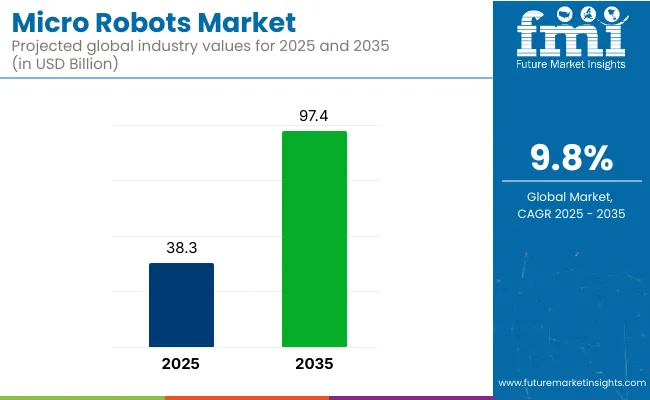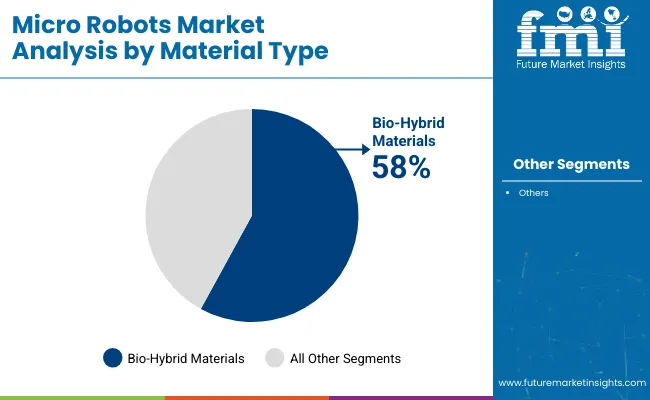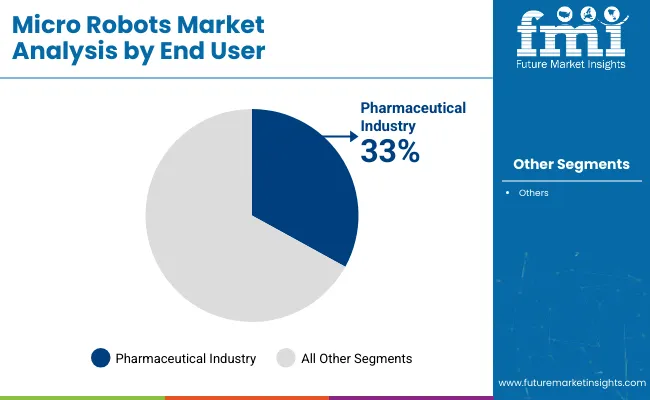The global micro robots market is projected to grow from USD 38.3 billion in 2025 to USD 97.4 billion by 2035, reflecting a CAGR of 9.8%. Growth is expected to be fueled by rapid technological innovations in nanotechnology, artificial intelligence, and miniaturization. Increased demand from industries such as healthcare, defense, and precision manufacturing is contributing to market expansion.

| Metric | Value |
|---|---|
| Industry Size (2025E) | USD 38.3 billion |
| Industry Value (2035F) | USD 97.4 billion |
| CAGR (2025 to 2035) | 9.8% |
Furthermore, the rising integration of AI-driven control systems and the adoption of biodegradable components are enhancing the viability of applications across complex sectors. Expanding government funding, academic R&D collaborations, and advancements in micro battery technology are further accelerating commercialization and cross-industry adoption.
Advancements in collective intelligence and magnetic actuation are accelerating the development of micro robots. The integration of soft robotics using bio-compatible materials is enabling safe navigation through complex biological environments. Bio-hybrid designs combining living cells with synthetic components are expected to enhance responsiveness and adaptability. Additionally, innovations in 3D nanofabrication are projected to support the creation of precision microstructures, expanding their role in drug delivery and diagnostics.
The USA is projected to be the fastest-growing market with a CAGR of 10.2% from 2025 to 2035. Bio-hybrid micro robots are expected to dominate the material segment with a 58% market share, while pharmaceutical applications will lead the end-user category, accounting for 33% of the market in 2025. Countries like Japan and Germany are also expected to experience rapid expansion, with CAGRs of 10.1% and 9.6%, respectively.
The micro robots market is segmented into material type, end use, and region. By material type, the market is divided into bio-hybrid and synthetic. Based on end use, the market is segmented into pharmaceutical industry, healthcare industry, automotive industry, manufacturing industry, and military. Regionally, the market is classified into North America, Latin America, Western Europe, Eastern Europe, East Asia, South Asia, and the Middle East and Africa (MEA).
The bio-hybrid segment is expected to lead, accounting for approximately 58% of the global market share in 2025.

The pharmaceutical industry is projected to grow this segment, capturing approximately 33% of the global market share by 2025, driven by growing demand for precision drug delivery and minimally invasive treatment solutions.

The global microrobots market is being driven by advancements in nanotechnology and artificial intelligence, as well as the rising demand for precision healthcare and industrial automation. However, it is also being challenged by high production costs, strict regulatory frameworks, and ethical concerns surrounding the autonomous deployment of robots.
Recent Trends in the Micro Robots Market
Challenges in the Micro Robots Market

The USA micro robots market is projected to grow at a CAGR of 10.2% from 2025 to 2035, making it the fastest-growing market globally. Strong investments by the Department of Defense and National Science Foundation, coupled with rising healthcare automation and semiconductor innovations, are expected to accelerate adoption across multiple sectors, including defense, healthcare, and precision manufacturing.
The UK micro robots market is forecasted to expand at a CAGR of 9.5% between 2025 and 2035. Growth is being supported by government initiatives that promote medical robotics, defense innovation, and smart factory automation, along with a rising demand for micro-scale solutions in hazardous and nuclear environments.
Germany’s micro robots market is estimated to grow at a CAGR of 9.6% during the forecast period, driven by robust industrial automation, automotive innovation, and smart manufacturing frameworks. The country’s leadership in precision engineering is positioning it as a key player in both healthcare and industrial micro robotics.
France’s micro robots market is forecasted to grow at a CAGR of 9.3% from 2025 to 2035, as applications grow across defense, healthcare, and environmental monitoring. The French government’s investments in robotics innovation, sustainability, and AI ethics are fostering a well-regulated, high-growth environment.
Japan’s micro robots market is expected to expand at a CAGR of 10.1% between 2025 and 2035, supported by a strong foundation in miniaturization, healthcare robotics, and industrial precision systems. Its aging population and high-tech R&D ecosystem are positioning Japan as a global hub for innovation in medical and consumer micro-robots.
The micro robots market is characterized by a fragmented yet increasingly competitive landscape. While top-tier companies hold significant shares, substantial opportunities remain for niche innovators to carve out specialized roles. Pricing, innovation, and strategic partnerships are being deployed as key strategies, as established players leverage scale and R&D budgets. At the same time, agile firms focus on breakthrough technologies, including AI, bio-hybrids, and swarm systems, to differentiate themselves.
Top companies are competing through various strategies, and firms like ABB and Omron are pursuing pricing advantages in industrial segments. In contrast, innovation is being prioritized by players such as SRI International and Boston Dynamics. Partnerships are being formed to accelerate product development, e.g., ABB partnering with Agilent Technologies for lab automation. Geographic expansion into emerging regions is being supported through targeted alliances and local R&D setups.
Recent Micro Robots Market News
| Report Attributes | Details |
|---|---|
| Market Size (2025) | USD 38.3 billion |
| Projected Market Size (2035) | USD 97.4 billion |
| CAGR (2025 to 2035) | 9.8% |
| Base Year for Estimation | 2024 |
| Historical Period | 2020 to 2024 |
| Projections Period | 2025 to 2035 |
| Report Parameter | Revenue in USD billion/Units |
| By Material Type | Bio-Hybrid Micro Robots, and Synthetic Micro Robots |
| By End Use | Pharmaceutical Industry, Healthcare Industry, Automotive Industry, Manufacturing Industry, and Military |
| Regions Covered | North America, Latin America, Europe, East Asia, South Asia & Pacific, Middle East & Africa |
| Countries Covered | United States, Canada, United Kingdom, Germany, France, China, Japan, South Korea, Brazil, Australia |
| Key Players | ABB Ltd., iRobot Corporation, SRI International, Omron Corporation, Boston Dynamics, Microbot Medical, Cyborg Nest, KUKA AG, Seiko Epson Corporation, FANUC Corporation |
| Additional Attributes | Dollar sales by value, market share analysis by region, and country-wise analysis. |
In terms of Material type, the industry is divided into Bio-Hybrid, Synthetic
In terms of End User, the industry is divided into Pharmaceutical Industry, Healthcare Industry, Automotive Industry, Manufacturing Industry, Military
The report covers key regions, including North America, Latin America, Western Europe, Eastern Europe, East Asia, South Asia, and the Middle East and Africa (MEA).
The market is expected to reach USD 97.4 billion by 2035.
The market is forecasted to grow at a CAGR of 9.8% during the period.
The bio-hybrid segment leads with a 58% share due to its biocompatibility.
The USA is the fastest-growing region, with a 10.2% CAGR.
Key players include ABB Ltd., iRobot Corporation, SRI International, and Boston Dynamics.






Full Research Suite comprises of:
Market outlook & trends analysis
Interviews & case studies
Strategic recommendations
Vendor profiles & capabilities analysis
5-year forecasts
8 regions and 60+ country-level data splits
Market segment data splits
12 months of continuous data updates
DELIVERED AS:
PDF EXCEL ONLINE
Electrically Actuated Micro Robots Market Size and Share Forecast Outlook 2025 to 2035
Microfilm Reader Market Size and Share Forecast Outlook 2025 to 2035
Micro-Dosing Sachet Fillers Market Analysis - Size and Share Forecast Outlook 2025 to 2035
Microbial Growth Monitoring System Market Size and Share Forecast Outlook 2025 to 2035
Micro Hotel Market Forecast and Outlook 2025 to 2035
Microwave Source Market Size and Share Forecast Outlook 2025 to 2035
Micro-energy Harvesting System Market Size and Share Forecast Outlook 2025 to 2035
Micro CHP Market Size and Share Forecast Outlook 2025 to 2035
Micro Irrigation System Market Size and Share Forecast Outlook 2025 to 2035
Micro Flute Paper Market Size and Share Forecast Outlook 2025 to 2035
Microcrystalline Cellulose Market Size and Share Forecast Outlook 2025 to 2035
Micro Balances Market Size and Share Forecast Outlook 2025 to 2035
Micro Perforated Films Packaging Market Size and Share Forecast Outlook 2025 to 2035
Microbial Coagulants Market Size and Share Forecast Outlook 2025 to 2035
Microserver IC Market Size and Share Forecast Outlook 2025 to 2035
Microplate Handling Instruments Market Size and Share Forecast Outlook 2025 to 2035
Microsclerotherapy Treatment Market Size and Share Forecast Outlook 2025 to 2035
MicroLED Photoluminescence Inspection System Market Size and Share Forecast Outlook 2025 to 2035
Micro-Scale VFFS Modules Market Analysis - Size and Share Forecast Outlook 2025 to 2035
Microscope Digital Camera Market Size and Share Forecast Outlook 2025 to 2035

Thank you!
You will receive an email from our Business Development Manager. Please be sure to check your SPAM/JUNK folder too.
Chat With
MaRIA